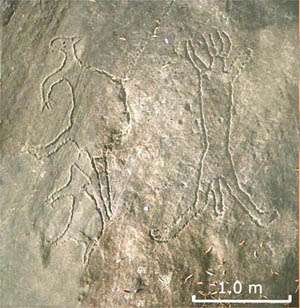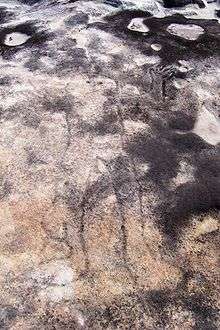Sydney rock engravings
Sydney rock engravings are a form of Australian Aboriginal rock art consisting of carefully drawn images of people, animals, or symbols, in the sandstone around Sydney, New South Wales, Australia. Many thousands of such engravings are known to exist in the Sydney region, although the locations of most are not publicised to prevent damage by vandalism, and to retain their sanctity, as they are still regarded as sacred sites by Indigenous Australians.

They are comparable with the petroglyphs of Native Americans and the rock art found elsewhere in Australia, but have their own distinctive style which is quite unlike rock art found anywhere else in Australia.
Origins
The engravings were made by the Aboriginal Australians who have lived in the Sydney region from about 25000 years ago until the present day.
The engravings cannot be dated directly with current archaeological techniques, necessitating the use of indirect dating.
The Aboriginal Australians arrived in the North of Australia around 50000 years ago, but the earliest evidence of occupation in the Sydney region is dated to about 10000 BC, in the Bidjigal Reserve in the Hills District of North-West Sydney. However, dates of over 20000 years have been found in the Blue Mountains, and so it is reasonable to suppose that Aboriginal people may have been in the Sydney region around then, although their settlements have not yet been discovered.
The Sydney engravings are of a style known as "simple figurative",[1] which conventional archaeology dates to the last 5000 years. Other engravings show European sailing ships, and so cannot be more than about 200 years old. The dates therefore range from 5000 to 200 years ago. It is likely that some of the freshest engravings represent the later part of that time range, whilst the most worn represent the earliest part. However, the situation is complicated by the fact that the engravings were sometimes "re-grooved" during ceremonies.
It has been claimed that some engravings appear to show thylacines and other mammals which have been extinct in the Sydney region for many thousands of years, and so are presumably that old. In support of this, it is certainly true that rock art elsewhere (e.g. Kakadu National Park) does show extinct animals, and so must be tens of thousands of years old. However, at the moment there is no hard evidence to support these claims for Sydney rock art.
Method of creation
Examination of the grooves shows that they were made in several stages as follows:
- Presumably, a sketched outline was scratched on to the surface of the rock.
- Then a series of holes was drilled along the line, using a pointed stone or shell, which is possible because the Sydney Basin sandstone is relatively soft.
- Finally, the holes were joined by rubbing a sharp stone along the line.
This results in a U-shaped groove which is typically about 2 centimetres deep and 2 centimetres wide. It is easily distinguished from natural grooves in the sandstone, which are usually V-shaped, modern grooves made with steel tools, which are usually narrower and deeper, or those made by bulldozers, which usually have a square section.
The grooves were often maintained by "re-grooving" during ceremonies, which complicates attempts at dating them.
Purpose
While their purpose is not known definitively, some educated guesses may be made by analogy with the culture of other indigenous groups who survived into modern times, as follows.
Some sites may have been "increase sites", where a ceremony would be held to increase the availability of a food source such as kangaroos or fish. It is thought that most of the sites depicting animals are of this type.
Another group of sites may have been where initiation ceremonies were held, to celebrate and facilitate the transition of a young boy into manhood. In other parts of Australia, we know that an initiation ceremony often involves a ceremonial path from childhood into manhood, and so the lines of steps, or mundoes, may indicate initiation sites.
Other sites show "Culture Heroes" or "Ancestral Beings" such as Baiame, who has a striped head-dress and often a striped body, and Daramulan who has a large club foot and may have been part-emu.
Some sites also show evidence of Aboriginal Astronomy.[2]
It should also be recognised that increase sites, initiation sites, culture-hero sites, and astronomical sites are not necessarily distinct, and one site may fall into any or all of these categories.
Gallery
See also
Further reading
- Sydney Rock Engravings
- Stanbury & Clegg, 1990, 'A Field Guide to Aboriginal Rock Engravings', Oxford University Press.
- Melinda Hinkson & Alana Harris, 2001, 'Aboriginal Sydney', ISBN 0-85575-370-6
- Ray Norris & Cilla Norris, 2009, 'Emu Dreaming', ISBN 978-0-9806570-0-5
- Sydney Rock Art
References
- ↑ Josephine Flood, 'Rock Art of the Dreamtime', ISBN 0-207-18908-0
- ↑ http://www.EmuDreaming.com




